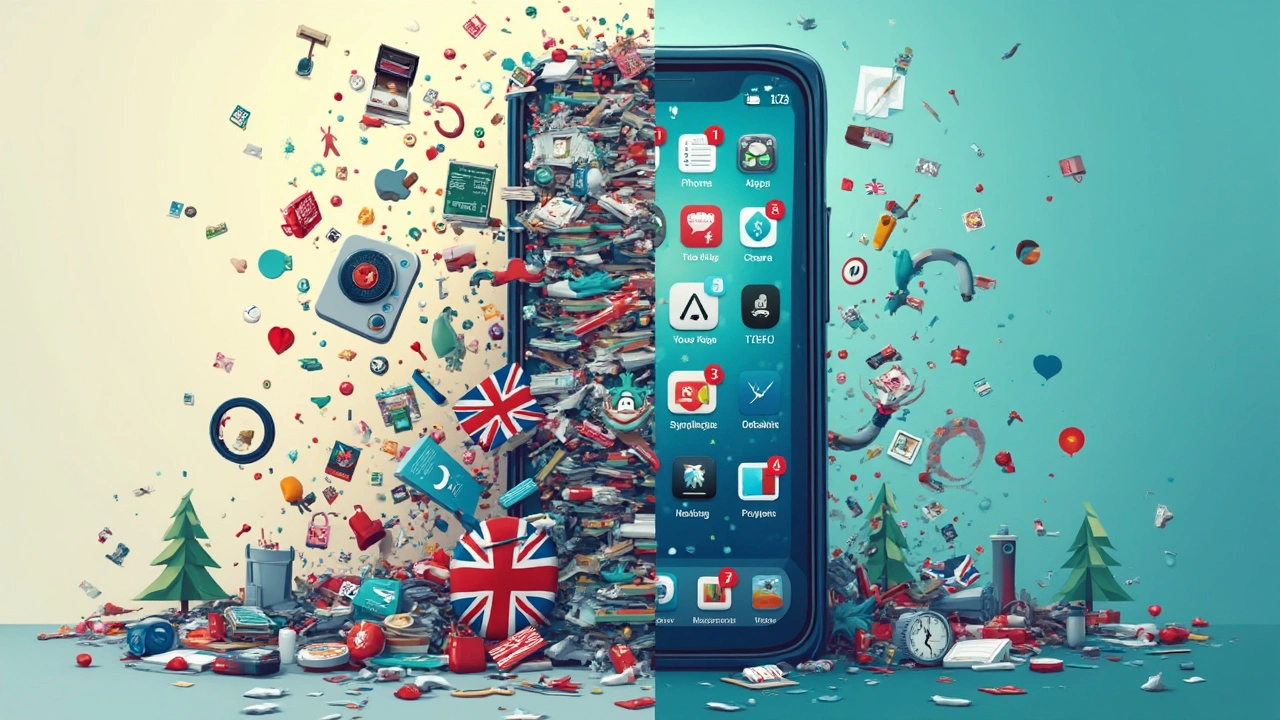How to Free Up Phone Storage Without Deleting Everything

Ever feel like your phone is bursting at the seams, but the thought of deleting stuff makes you cringe? Been there! Many of us reach a point where our smartphones send those dreaded 'storage full' alerts, and it's like, 'Not now, phone!' The good news? You don't have to lose your precious photos or the must-have playlist to make room for new things.
Let’s talk about some clever ways to manage that storage. First, take a look at what's actually hogging all that space. Is it apps, videos, or maybe those memes you've hoarded for years? Diving into your settings can unveil the culprits.
Another game-changer is diving into the magical world of cloud storage. Services like Google Drive or iCloud offer a simple escape: stash your stuff online and access it whenever you need without taking up phone space.
- Understanding What's Eating Your Storage
- The Magic of Cloud Storage
- Managing Apps Wisely
- Using Built-in Phone Features
- External Storage Options
Understanding What's Eating Your Storage
When your phone storage runs low, it’s like a mystery—what’s taking up all that space? Time to play detective! First, do a quick rundown by going into your phone's settings and checking out the storage section. Most smartphones lay it all out for you, showing what’s taking the most space like apps, photos, or the mysterious 'other' category.
Let's start with photos and videos. They’re often the biggest culprits. A single high-resolution video can gobble up GBs of space. Go through your gallery regularly to spot duplicates or those accidental pocket shots that snuck in.
Apps are another biggie. Some apps, especially those you downloaded ages ago and forgot about or those you're saving for the rare 'just in case' scenario, may be eating up space with data and cache. Consider whether you’re still using all of them. You can find this info in Settings under 'Apps' where you can see how much data each app uses.
Then there’s the infamous 'other' category. It's like a catch-all for files and data, including browser caches and system files. Regularly clearing your browser cache can help here. Also, messaging apps might be stockpiling a ton of data with attachments and chat backups. Take a peek in those app settings too.
- Step 1: Head to your Settings and look for Storage options.
- Step 2: Check the list of what's using space.
- Step 3: Review your gallery and apps for stuff you don’t need.
- Step 4: Clear caches, especially in browsers and messaging apps.
Understanding what's behind the storage alerts isn't just about space—it’s about knowing your phone better and keeping it happy and fast. And remember, once you identify the storage solutions you need, you can manage it better without losing the stuff you care about.
The Magic of Cloud Storage
Ever wondered how you can continue snapping away or downloading those binge-worthy shows without your phone giving you the cold shoulder about space? Say hello to cloud storage. It's like having an extra storage room in the digital world where you can keep your stuff without lugging it around everywhere you go.
First off, cloud storage platforms like Google Drive, iCloud, and Dropbox allow you to move files and photos off your phone while keeping them secure. Imagine having easy access to your favorite 2019 vacation photos or your best friend's wedding videos anytime you need, without bogging down your actual phone storage.
To get started, you'll need to sign up for a service—most offer a few gigabytes for free, while a small monthly fee can push that space to a terabyte or more. Here's a quick guide:
- Download the app for your chosen cloud service.
- Create an account and sign in.
- Select the files or folders you want to back up and hit 'upload'.
- Set up automatic backups for new photos or important documents.
This is particularly awesome if you're juggling multiple devices because you can sync everything. Tired of those annoying storage alerts? Consider turning on automatic syncing for photos and media files.
And hey, you might be asking about security, right? It’s a legit concern, but these services use encryption to keep your stuff safe and sound. If you’re keen on numbers, iCloud recently boasted around 850 million users for its storage services as of 2024, which says a lot about trust and popularity.
In the end, leveraging cloud storage is like having an invisible backpack for your virtual belongings—light, spacious, and super handy. It’s a game-changer for keeping your phone’s performance slick and your memories readily available without scrolling through 'storage full' pop-ups.

Managing Apps Wisely
When it comes to freeing up phone storage, apps are often the biggest space gobblers. But you don't have to delete everything; just get smart about how you handle them.
First off, check which apps are eating all your space. Head into your phone settings and look for storage or apps. Here, you'll see a list of apps sorted by size. Spoiler alert: games and social media apps like Instagram or Facebook usually top the list.
Once you know what's what, consider these strategies:
- Offload unused apps: Both iOS and Android have features to offload or temporarily remove apps you don't use often. They'll stay on your home screen but won't take up space.
- Clear app caches: Many apps store data you don't really need. Head to app settings and clear the cache regularly, especially for social media apps.
- Opt for lite versions: Some popular apps have 'lite' versions. These use less storage and data. Check if any of your heavy apps have lighter alternatives.
Re-assessing how you manage apps ensures you get the best out of your storage solutions without sacrificing functionality. Plus, keeping your apps in check can make navigation faster and smoother, giving you a better overall phone experience.
Using Built-in Phone Features
Most of our smartphones come packed with handy features that, if used right, can be real lifesavers when it comes to clearing storage. If you're in constant battle with the dreaded 'storage full' alert, it's time to explore these options. Let's break down how you can use what's already included in your device to free up some space.
First, every phone typically has a storage analysis tool. On iPhones, go to 'Settings' > 'General' > 'iPhone Storage,' while Android users can head to 'Settings' > 'Storage.' This tool gives you a detailed view of what's taking up space. It'll categorize the data into apps, photos, videos, and so on, helping you understand what you can possibly remove or relocate.
For those App addicts, both iOS and Android offer ways to manage them effectively. iPhones have the 'Offload Unused Apps' feature, found under 'Settings' > 'App Store.' This automatically removes apps you don’t use regularly while keeping their data intact. When you need them again, just reinstall, and you’re good to go! Android users can use the 'Free Up Space' tool found in the storage settings, which suggests apps and files to remove based on your usage.
Another feature to leverage is managing photos. On iPhones, the 'Optimize iPhone Storage' option under the 'Photos' setting in iCloud compresses photos for your device while uploading full-resolution versions to the cloud. This keeps precious memories safe without bloating your storage. Android offers a similar feature through Google Photos—just turn on 'Free Up Space' and let the cloud handle the bulk of your media.
Let's not forget about the cache files. They seem tiny but can accumulate over time. Head over to your browser app settings, and you'll find options to clear cache data. It's worth doing this every once in a while to keep things tidy.
Here's a little table showing the typical space usage categories and some suggestions for managing them efficiently:
| Category | Tips for Clearing Space |
|---|---|
| Apps | Offload unused or rarely used apps |
| Photos | Use cloud storage like iCloud or Google Photos |
| Cache Files | Regularly clear from browser settings |
| Messenger Attachments | Delete unnecessary images/files from chat threads |
So before you rush to delete your favorite app or photo, remember that most smartphones already have built-in tools to help you manage phone storage effectively. It's like having a personal assistant in your pocket, ensuring you never run out of space for what's important to you.

External Storage Options
Alright, so you're trying to clear up space on your phone but without dumping everything. Here's a nifty trick: use external storage options. It's like having an extra room for your stuff!
If you've got an Android phone with a microSD slot, you're in luck. Just slide in a microSD card and move some files over, especially the big stuff like videos and photos. It’s as easy as pie and can instantly free up loads of space.
For those rocking an iPhone, external storage is a bit different. Since Apple's devices don’t have microSD slots, you'll need an external storage drive that plugs into the Lightning port. They're like USB sticks but made for iPhones. Some popular brands are SanDisk and Kingston.
"Using an external storage device can dramatically expand your device capacity while ensuring your data remains portable," says tech expert Dana Clarke.
Need something smaller? OtterBox has a neat little gadget called a flash drive with dual connectivity that works with many phones without hassle. Just copy, paste, and you’re golden.
Plus, an external drive can keep your data safe and within reach anytime you need it, all without cloud storage's ongoing fees. And if you've got multiple devices at home, one drive can make it easier to share files across devices.
Thinking about which size or brand to choose? Here's a quick guide:
- 32GB or 64GB: Perfect for storing a few movies, thousands of documents, and a whole bunch of music.
- 128GB or more: Go for this if you're capturing video on the regular or collect massive files.
Before you go on a shopping spree, just make sure the external storage you pick is compatible with your phone. Check the ports and read a few reviews, so you’re getting exactly what you need. This way, your phone storage worries are one less thing to stress about.





